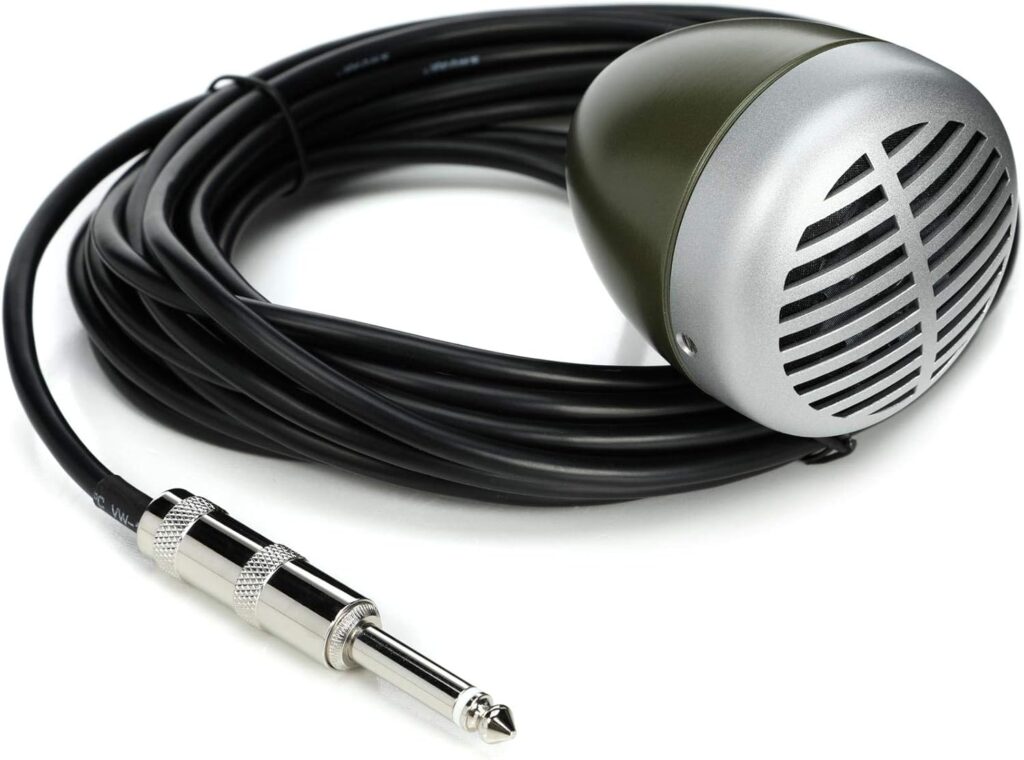Best Harmonica Microphones(All Budgets)
The harmonica, affectionately known as the harp, is one of the most expressive instruments in blues, folk, rock, and country music. While an acoustic harmonica can fill a small room with its soulful voice, amplifying it properly requires the right microphone. Whether you’re playing intimate blues sessions or rocking out on stage with a full band, choosing the right harmonica microphone can make the difference between a mediocre performance and one that truly moves your audience.
What are the Best Harmonica Microphones?
Here is my top picks for the best harmonica microphones in 2025.
1. Shure Green Bullet 520DX

The Shure Green Bullet 520DX tops our list as the quintessential harmonica microphone. This modern interpretation of the classic bullet mic delivers the authentic Chicago blues tone that harmonica legends like Little Walter and Sonny Boy Williamson II made famous. The 520DX features a distinctive green die-cast casing and produces a warm, compressed sound with natural distortion that cuts through any band mix.
What sets the Green Bullet apart is its controlled magnetic field design, which reduces electromagnetic hum and provides excellent rejection of background noise. The built-in cable eliminates the need for a separate microphone cable, and its rugged construction can withstand the rigors of live performance.
Pros:
- Authentic vintage blues tone
- Excellent feedback rejection
- Rugged construction
- Built-in cable
- Affordable price point
Cons:
- Limited frequency response
- Heavy weight can cause hand fatigue
- Not ideal for clean, acoustic-style playing
2. Shure SM57
The legendary Shure SM57 earns the second spot for its incredible versatility and reliability. While not specifically designed for harmonica, the SM57 has been used by countless professionals for both live performance and studio recording. Its cardioid pickup pattern provides excellent isolation, and its flat, wide-range frequency response captures the harmonica’s full tonal spectrum.
The SM57’s reputation for durability is unmatched in the industry. It can handle extreme sound pressure levels and has been known to survive decades of abuse while maintaining consistent performance. Many harmonica players appreciate its clean, uncolored sound, which allows the natural character of their instrument and playing style to shine through.
Pros:
- Exceptional build quality and reliability
- Versatile for multiple applications
- Excellent frequency response
- Great value for money
- Industry standard
Cons:
- Requires proper mic technique for optimal tone
- May need EQ adjustment for desired harmonica sound
- No built-in cable
3. Hohner Blues Blaster
The Hohner Blues Blaster secures third place as an excellent entry-level option that doesn’t compromise on sound quality. Designed specifically for harmonica players, this microphone delivers a warm, woody tone reminiscent of vintage bullet mics at a fraction of the cost.
The Blues Blaster features a unique design that fits comfortably in the hands and provides good control over cupping technique. Its frequency response is tailored to enhance the harmonica’s midrange frequencies, resulting in a sound that cuts through band mixes effectively.
Pros:
- Harmonica-specific design
- Great tone for the price
- Comfortable to hold and cup
- Built-in cable
- Lightweight
Cons:
- Build quality not as robust as higher-end options
- Limited high-frequency response
- May not satisfy professional players long-term
4. Astatic JT-30
The Astatic JT-30 claims fourth place as the holy grail of vintage harmonica microphones. Originally manufactured from the 1940s through the 1980s, genuine JT-30s are highly sought after by serious blues players. When properly maintained and modified, they produce an unmatched vintage tone with natural compression and harmonic distortion.
Finding an authentic JT-30 in good working condition can be challenging, and they often require modification or restoration to function optimally with modern equipment. However, for players seeking the most authentic vintage sound, nothing quite compares to a well-maintained JT-30.
Pros:
- Unmatched vintage authenticity
- Unique compression and distortion characteristics
- Highly prized by collectors and professionals
- Distinctive appearance
Cons:
- Difficult to find in good condition
- Often requires modification or restoration
- Expensive when in good condition
- Fragile compared to modern microphones
5. Electro-Voice RE20
The Electro-Voice RE20 ranks fifth for its exceptional performance in studio applications. This broadcast-standard microphone offers outstanding clarity and a flat frequency response that captures every nuance of harmonica performance. Its Variable-D technology minimizes proximity effect, ensuring consistent tone regardless of playing distance.
While the RE20 excels in controlled environments, its large size and weight make it less practical for live performance cupping techniques. However, for recording applications where pristine audio quality is paramount, the RE20 is hard to beat.
Pros:
- Exceptional audio quality
- Minimal proximity effect
- Professional broadcast standard
- Excellent isolation
- Durable construction
Cons:
- Expensive
- Large and heavy
- Not suitable for cupping techniques
- Requires phantom power for optimal performance
6. Audio-Technica ATM410
The Audio-Technica ATM410 takes sixth place as an excellent modern dynamic microphone for harmonica. Its cardioid pattern provides good feedback rejection, while its frequency response is tailored to enhance vocal presence – which translates well to harmonica applications.
The ATM410 offers a more modern, Hi-Fi sound compared to vintage-style microphones, making it suitable for players who prefer cleaner amplification with less natural distortion. Its build quality is excellent, and it performs consistently across various live sound environments.
Pros:
- Clean, modern sound
- Good feedback rejection
- Solid build quality
- Versatile for multiple instruments
- Reasonable price
Cons:
- May lack character for traditional blues applications
- Heavier than some alternatives
- Less distinctive than specialized harmonica mics
7. Sennheiser MD 421-II
The Sennheiser MD 421-II ranks seventh for its legendary status in professional recording studios. This microphone’s five-position bass roll-off switch allows for precise tonal shaping, making it adaptable to different harmonica styles and recording environments.
The MD 421-II’s frequency response curve naturally emphasizes the presence range, which helps harmonica cut through dense mixes. Its exceptional handling noise rejection and rugged construction make it suitable for both studio and live applications, though its size makes traditional cupping techniques challenging.
Pros:
- Legendary professional reputation
- Adjustable bass response
- Excellent handling noise rejection
- Versatile applications
- Outstanding build quality
Cons:
- High price point
- Large size limits cupping options
- May be overkill for simple harmonica applications
8. Blue Yeti (Condenser)
The Blue Yeti claims eighth place as the best USB option for home recording enthusiasts. While not traditionally associated with harmonica, its multiple pickup patterns and direct-to-computer connectivity make it an excellent choice for bedroom producers and online content creators.
The Yeti’s condenser capsule captures detailed harmonica recordings with excellent clarity. Its cardioid mode works well for close-mic harmonica recording, while the omnidirectional mode can capture room ambiance for a more spacious sound.
Pros:
- Convenient USB connectivity
- Multiple pickup patterns
- Good value for home recording
- Easy to use with recording software
- Built-in headphone monitoring
Cons:
- Not suitable for live performance
- Requires careful room treatment
- Less character than dynamic alternatives
- Sensitive to handling noise
9. Royer R-121
The Royer R-121 ribbon microphone takes ninth place for its exceptional performance in high-end studio applications. Ribbon microphones are prized for their smooth, natural sound character, and the R-121 represents the pinnacle of modern ribbon design.
For harmonica recording, the R-121 captures incredible detail and warmth, with a natural compression that complements the instrument beautifully. However, its high cost and delicate nature limit its accessibility to professional studios and serious recording enthusiasts.
Pros:
- Exceptional sound quality
- Natural compression and warmth
- Professional studio standard
- Unique ribbon character
- Excellent for ambient recording
Cons:
- Very expensive
- Extremely delicate
- Requires phantom power
- Not suitable for live performance
- Limited availability
10. Peavey H-5C Cherry Bomb
Rounding out our top ten, the Peavey H-5C Cherry Bomb offers a budget-friendly entry into harmonica-specific microphones. Designed to emulate the classic bullet mic aesthetic and sound, the Cherry Bomb delivers surprising performance for its price point.
While it doesn’t quite match the build quality or tonal complexity of higher-ranked microphones, the Cherry Bomb provides an accessible way for beginning players to experience authentic blues harmonica amplification without breaking the bank.
Pros:
- Very affordable
- Harmonica-specific design
- Decent tone for the price
- Lightweight and portable
- Good for beginners
Cons:
- Build quality concerns
- Limited frequency response
- May not satisfy experienced players
- Less sophisticated sound than premium options
Final Thoughts
In summary , the perfect harmonica microphone depends on your individual needs, playing style, and budget. The Shure Green Bullet 520DX stands out as our top recommendation for its combination of authentic blues tone, durability, and accessibility. However, each microphone in our ranking offers unique advantages for different applications.
Whether you’re a beginner exploring the world of amplified harmonica or a professional seeking to refine your sound, understanding these options helps you make an informed decision. Remember that the best microphone is ultimately the one that inspires you to play and helps you express your musical vision most effectively.
The journey to finding your perfect harmonica microphone may involve trying several options, but the reward – that perfect synthesis of player, instrument, and technology – makes the effort worthwhile. As you develop your skills and refine your sound, your microphone becomes not just a tool for amplification, but an integral part of your musical expression.

